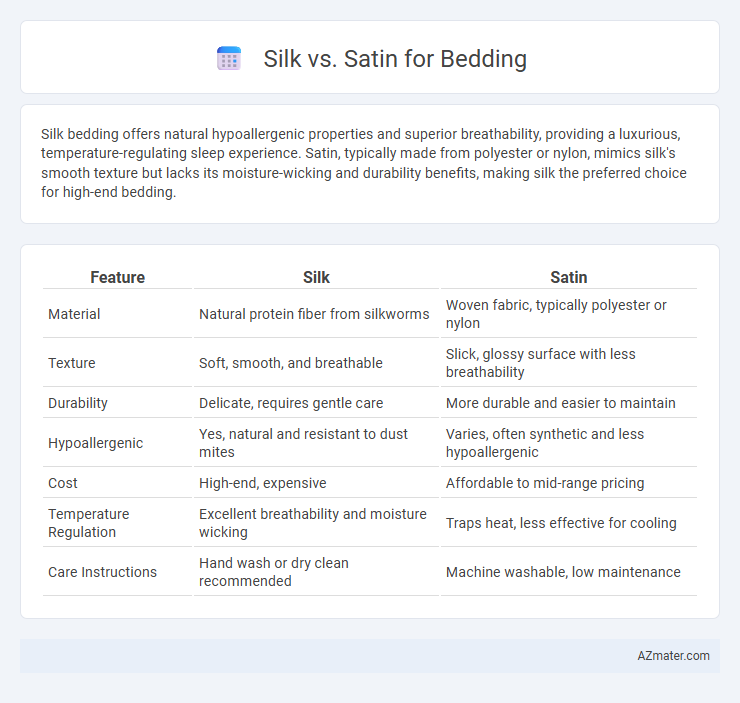Silk bedding offers natural hypoallergenic properties and superior breathability, providing a luxurious, temperature-regulating sleep experience. Satin, typically made from polyester or nylon, mimics silk's smooth texture but lacks its moisture-wicking and durability benefits, making silk the preferred choice for high-end bedding.
Table of Comparison
| Feature | Silk | Satin |
|---|---|---|
| Material | Natural protein fiber from silkworms | Woven fabric, typically polyester or nylon |
| Texture | Soft, smooth, and breathable | Slick, glossy surface with less breathability |
| Durability | Delicate, requires gentle care | More durable and easier to maintain |
| Hypoallergenic | Yes, natural and resistant to dust mites | Varies, often synthetic and less hypoallergenic |
| Cost | High-end, expensive | Affordable to mid-range pricing |
| Temperature Regulation | Excellent breathability and moisture wicking | Traps heat, less effective for cooling |
| Care Instructions | Hand wash or dry clean recommended | Machine washable, low maintenance |
Introduction to Silk and Satin Bedding
Silk bedding, crafted from natural protein fibers produced by silkworms, offers exceptional softness, breathability, and temperature regulation properties, making it ideal for maintaining skin hydration and reducing hair frizz. Satin bedding, known for its glossy surface and smooth texture, is typically made from synthetic fibers like polyester or natural fibers like silk, providing an affordable, silky feel with less breathability than pure silk. Both silk and satin enhance bedroom aesthetics and comfort, but silk is prized for its hypoallergenic qualities and luxury, while satin delivers a budget-friendly option with similar tactile benefits.
Origins and Composition of Silk
Silk, a natural protein fiber produced by silkworms, has been cultivated for over 5,000 years, originating in ancient China. Composed primarily of fibroin, silk boasts unparalleled softness, breathability, and hypoallergenic properties, making it a luxurious choice for bedding. While satin refers to a weaving technique that can use various fibers like polyester or silk, true silk bedding offers distinct natural benefits linked to its unique sericulture origins and molecular structure.
Origins and Composition of Satin
Satin, originally developed in China during the Middle Ages, is a weaving technique rather than a type of fiber, traditionally made from silk but now commonly produced with polyester or nylon fibers for affordability and durability. Its characteristic glossy surface and smooth texture result from a unique weave that allows more warp threads to float on the surface, reflecting light to create its signature sheen. Unlike silk, which is a natural protein fiber harvested from silkworm cocoons, satin's composition varies widely, influencing its breathability and maintenance requirements in bedding applications.
Texture and Feel: Silk vs. Satin
Silk bedding offers a naturally smooth, breathable texture that feels cool and luxurious against the skin, promoting comfort and temperature regulation. Satin, typically made from synthetic fibers like polyester, provides a glossy, slick surface but lacks silk's natural breathability and softness. The difference in texture and feel means silk is often preferred for its hypoallergenic properties and moisture-wicking ability, while satin attracts users seeking affordability with a shiny finish.
Breathability and Temperature Regulation
Silk bedding offers superior breathability due to its natural protein fibers, allowing better air circulation and moisture-wicking properties that keep sleepers cool in summer and warm in winter. Satin, often made from synthetic fibers like polyester, lacks the same breathability and can trap heat, making it less effective for temperature regulation. Choosing silk over satin enhances comfort by maintaining a balanced sleep environment through its responsive thermal properties and moisture management.
Durability and Longevity Comparison
Silk bedding offers natural strength with a tensile strength of up to 190 MPa, ensuring moderate durability but requires careful maintenance to prevent damage from moisture and sunlight. Satin, typically made from polyester or nylon fibers, provides higher abrasion resistance and is more resilient to everyday wear and tear, making it a longer-lasting option for frequent use. While silk excels in luxurious softness and breathability, satin bedding generally outperforms silk in durability and longevity under regular household conditions.
Skin and Hair Benefits: Which Is Better?
Silk bedding is renowned for its natural protein structure and hypoallergenic properties that help reduce friction on skin and hair, minimizing wrinkles and split ends. Satin, typically made from synthetic fibers, lacks these natural benefits but still offers a smooth surface that can prevent hair breakage and reduce skin irritation compared to cotton. For optimal skin hydration and hair health, 100% mulberry silk remains the superior choice due to its breathability and moisture-retaining properties.
Maintenance and Care Requirements
Silk bedding requires delicate care, including hand washing or using a gentle cycle with mild detergent, and should be air-dried away from direct sunlight to preserve its natural fibers and prevent damage. Satin, often made from polyester or nylon, is generally more durable and can be machine washed on a gentle cycle, making it easier to maintain compared to silk. Both materials benefit from avoiding harsh chemicals and ironing at low temperatures to maintain their smooth texture and longevity.
Cost and Value Analysis
Silk bedding typically commands a higher price due to its natural protein fibers, hypoallergenic properties, and luxurious texture, making it a premium investment for long-term comfort and skin health. Satin, often made from synthetic fibers like polyester, offers a more affordable alternative with a smooth, glossy finish but lacks the breathability and durability of silk. When analyzing value, silk provides superior moisture-wicking and temperature regulation, justifying its cost for those seeking high-end, sustainable bedding options.
Final Verdict: Choosing the Right Bedding Fabric
Silk offers superior breathability and natural temperature regulation, making it ideal for those seeking luxury and skin benefits, while satin provides a more affordable, glossy alternative with smooth texture and easy maintenance. Choosing the right bedding fabric depends on personal preferences, budget, and desired care level, with silk catering to sensitive skin and satin appealing to those prioritizing durability and cost-effectiveness. For optimal comfort and elegance, silk is preferred, but satin remains a practical choice for stylish, budget-friendly bedding.

Infographic: Silk vs Satin for Bedding
 azmater.com
azmater.com